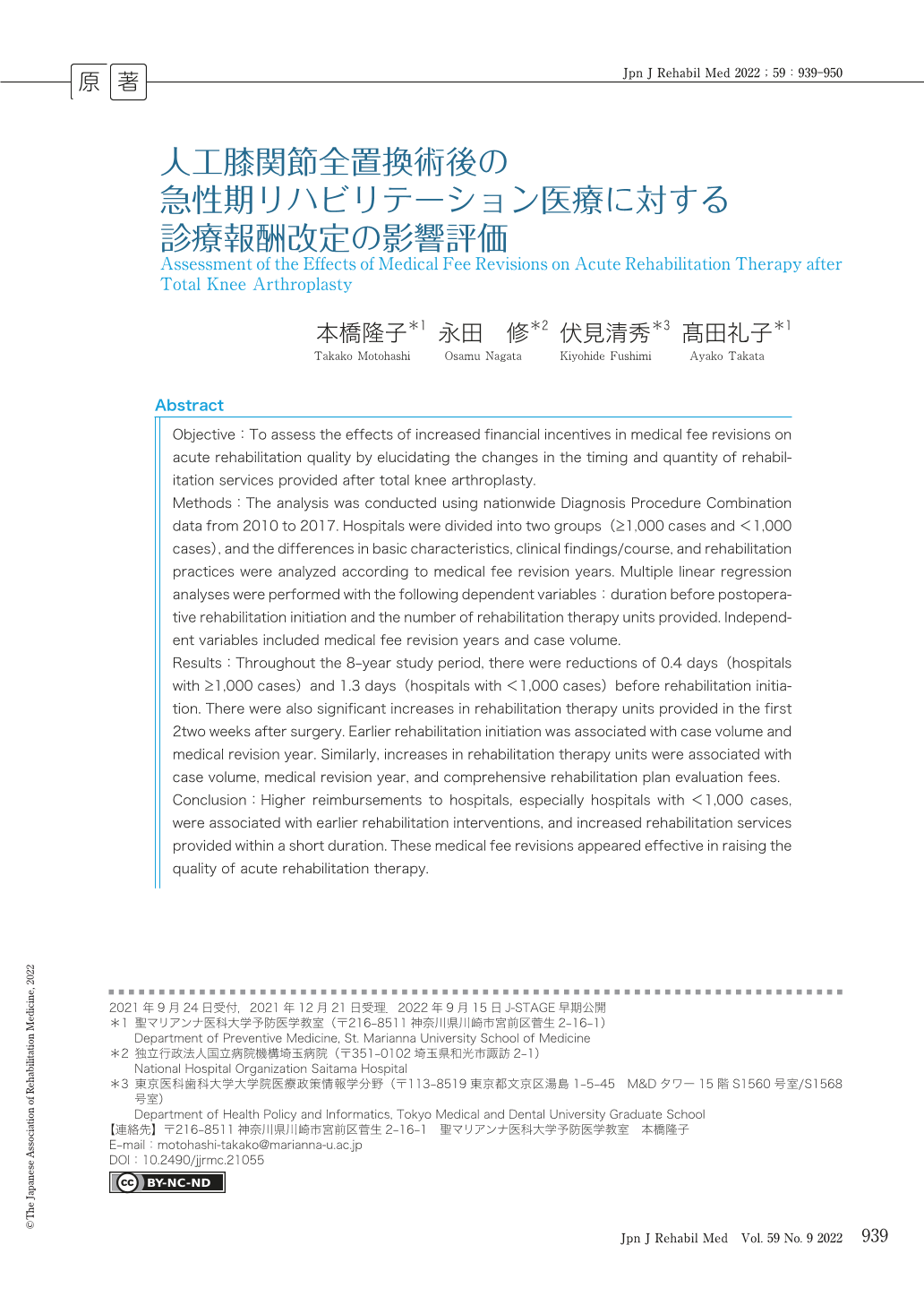Japanese
English
- 販売していません
- Abstract 文献概要
- 1ページ目 Look Inside
- 参考文献 Reference
要旨
目的:診療報酬改定によるインセンティブの増額が人工膝関節全置換術後リハビリテーション医療開始のタイミングや提供量に及ぼす変化を明らかにすることで,急性期リハビリテーション医療の質への影響を評価する.
方法:2010〜2017年の全国のDPCデータを用いて,8年間の症例数が1,000症例以上と1,000症例未満の病院に層別化し,診療報酬改定年度別に基本属性,臨床所見・経過,リハビリテーション実施状況の差の有意性を検討した.また,術後リハビリテーション開始までの期間と実施単位数を目的変数,診療報酬改定年度,症例数などを説明変数として重回帰分析を行った.
結果:1,000症例以上と1,000症例未満では,リハビリテーション開始までの期間は8年間で0.4日と1.3日有意に短縮した.術後1週目の実施単位数は3.2単位と2.8単位,術後2週目は1.8単位と3.7単位有意に増加した.また,リハビリテーション開始までの期間の短縮には症例数の多さと診療報酬改定年度,実施単位数の増加には症例数の多さと診療報酬改定年度,リハビリテーション総合計画評価料算定が関連していた.
結論:診療報酬の増額は,特に1,000症例未満の病院の早期開始と提供量の増加を短期間で実現し,急性期リハビリテーション医療の質の底上げ効果が示唆された.
Abstract
Objective:To assess the effects of increased financial incentives in medical fee revisions on acute rehabilitation quality by elucidating the changes in the timing and quantity of rehabilitation services provided after total knee arthroplasty.
Methods:The analysis was conducted using nationwide Diagnosis Procedure Combination data from 2010 to 2017. Hospitals were divided into two groups (≥1,000 cases and <1,000 cases), and the differences in basic characteristics, clinical findings/course, and rehabilitation practices were analyzed according to medical fee revision years. Multiple linear regression analyses were performed with the following dependent variables:duration before postoperative rehabilitation initiation and the number of rehabilitation therapy units provided. Independent variables included medical fee revision years and case volume.
Results:Throughout the 8-year study period, there were reductions of 0.4 days (hospitals with ≥1,000 cases) and 1.3 days (hospitals with <1,000 cases) before rehabilitation initiation. There were also significant increases in rehabilitation therapy units provided in the first 2two weeks after surgery. Earlier rehabilitation initiation was associated with case volume and medical revision year. Similarly, increases in rehabilitation therapy units were associated with case volume, medical revision year, and comprehensive rehabilitation plan evaluation fees.
Conclusion:Higher reimbursements to hospitals, especially hospitals with <1,000 cases, were associated with earlier rehabilitation interventions, and increased rehabilitation services provided within a short duration. These medical fee revisions appeared effective in raising the quality of acute rehabilitation therapy.

Copyright © 2022, The Japanese Association of Rehabilitation Medicine. All rights reserved.


